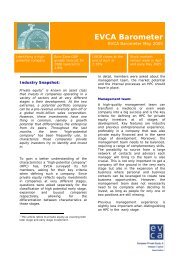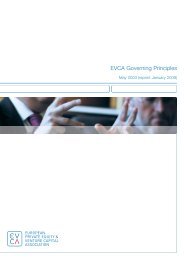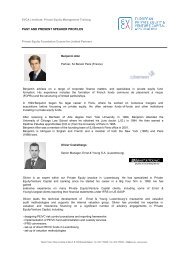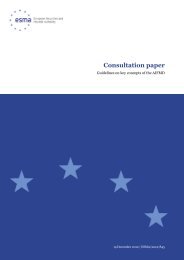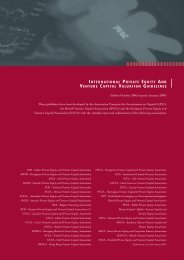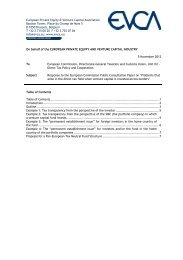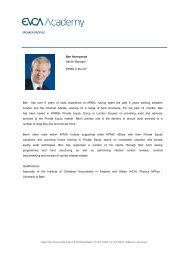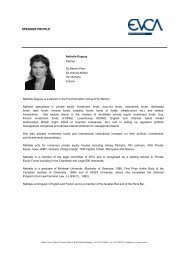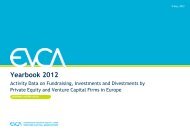Risk Measurement Guidelines - EVCA
Risk Measurement Guidelines - EVCA
Risk Measurement Guidelines - EVCA
Create successful ePaper yourself
Turn your PDF publications into a flip-book with our unique Google optimized e-Paper software.
4.1.2 Limitations and disadvantages of using an NAV-timeseries-based modelThe NAV-time series-based models may look reasonablysimple and are thought to be easy to implement. They can beappropriate for funds whose values derive mainly from thevalue of their existing underlying portfolio companies andwhere undrawn commitments can be ignored. However, suchmodels have a number of limitations and disadvantages.In particular, they often violate the criteria for proper riskmeasurement:> NAV-based models can be incomplete as they do not takeinto consideration a fund’s future use of the undrawncommitments, the future management fees and the fundmanager’s value added (or value destroyed). This mattersin particular for portfolios of young funds.> Rather than being random movements, changes in theNAV often reflect the lifecycle characteristics of privateequity funds, such as the J-curve. Whether the degree ofNAV change exposes a limited partner to risk depends onwhether this change is atypical for the fund’s stage andatypical relative to its peer group. A model should filterout such systematic biases.> The NAV often does not move in the same way as the valueof the limited partner’s interest in the fund. The conceptof market risk at the portfolio company level can beproblematic from the perspective of a fund’s limitedpartners: a limited partner cannot initiate the sell-offa portfolio company; this is entirely within the controlof the fund managers.Consequently, the fund’s value is derived from valuechanges in portfolio companies but does not necessarilymove in the same proportion. In fact, it could be arguedthat the entire purpose of the fund is shielding fledglingportfolio companies or companies that are beingrestructured from disruptive market influences.Disadvantages mainly relate to a number of technicalcomplications that need to be addressed:> The NAV-time series approach tries to project the fund’sfuture development based on a relatively short history.For private equity funds the frequency at which the NAV isdetermined is limited and it is not possible for informationto be more granular than quarterly. This gives limited datapoints with which to perform analysis, which createsa dilemma as trying to use the richest possible set ofrelevant data also leads to the possibility of distortionresulting from autocorrelation.> In cases where significant commitments to new funds– with no portfolio companies and therefore no NAV –are added to a portfolio, the return calculation can givemisleading signals, e.g. when there are far more capitalcalls than distributions, the value change will underestimatevolatility. Comparable issues can occur for small NAVscompared to the size of the cash flows.4.2 Cash flow-volatility-based modellingapproachCash flow-based modelling methodologies can be used tomeasure various risks of investing in private equity funds.The method is based on cash flow projections, which areused to derive the net present value (NPV) of investmentsunder different scenarios. Cash flows are discounted usingappropriate risk-adjusted rates that quantify the riskinherent in the future cash flows.Investors use a variety of models based on cash flow forecaststo assess the risks of their private equity investments.The simplest cash flow projections make assumptions aboutthe levels of draw-downs and distributions over the lifetimeof an average fund as observed historically, and apply thisto the funds invested in to come up with an aggregate forthe portfolio.4.2.1 Basic approachTo calculate the VaR we need to determine the probabilitydistribution for the valuation for a portfolio of funds at t1>t0(typically quarterly or annually). This is done by simulatinga large number of samples for scenarios of fund cash flowsover their full lifetime as opposed a time series analysis andthen to annualise “backward” (see Figure 2).<strong>EVCA</strong> <strong>Risk</strong> <strong>Measurement</strong> <strong>Guidelines</strong> 2013 I 17



